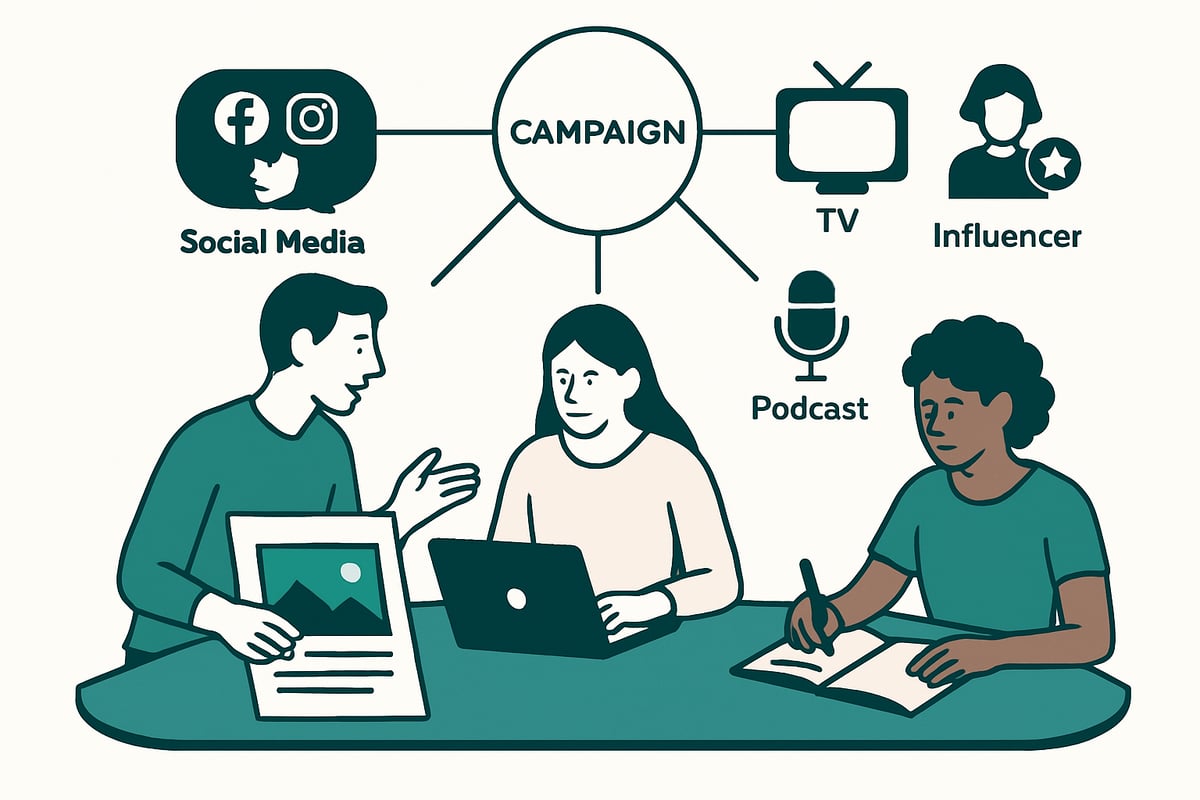Advertising Project Guide: Your Roadmap to Success in 2026

In the fast-paced world of advertising, staying ahead requires more than just creativity. The landscape is evolving rapidly, and in 2026, a well-structured approach is essential for every advertising project to succeed.
This guide equips you with a step-by-step roadmap to build, execute, and optimize your next campaign. You will discover proven methods for planning, assembling the right team, developing creative assets, launching campaigns, measuring results, and continuously adapting to new trends.
Ready to amplify your results? Explore future-focused strategies and actionable insights that ensure your advertising project delivers measurable impact. Follow along for a clear path to project success in the year ahead.
Step 1: Setting Clear Objectives and KPIs
In any successful advertising project, setting clear objectives is the foundation that drives every decision. Without defined goals, campaigns risk drifting off course or failing to deliver meaningful results. In 2026, aligning your advertising project with measurable business outcomes is more critical than ever.
Start by identifying what you want your advertising project to achieve. Common objectives include brand awareness, lead generation, and direct sales. Each objective should translate into specific, actionable targets. For example, are you aiming to increase website traffic by 30% or generate 500 qualified leads in Q1?
Types of Objectives:
- Brand awareness
- Lead generation
- Sales growth
- Customer retention
Establishing measurable KPIs for each objective ensures you can track progress and optimize performance. Use the SMART framework—Specific, Measurable, Achievable, Relevant, Time-bound—to set goals that are both ambitious and realistic.
| Campaign Example | Objective Clarity | Result |
|---|---|---|
| Campaign A | Clear, SMART KPIs | High ROI |
| Campaign B | Vague goals | Low engagement |
A 2024 HubSpot study found that 85% of high-performing campaigns had specific, measurable objectives. This underscores the value of defining what success looks like before launching your advertising project.
Set realistic timelines and budget expectations early. Align your objectives with your overall marketing strategy to ensure consistency and maximize impact. For more on how to track and improve your KPIs, see Marketing Analytics Lead You to Better Results.
With clear objectives and KPIs, your advertising project is primed for measurable success in a rapidly evolving market.
Step 2: Building the Right Team and Partnerships
Assembling the right team is the cornerstone of a successful advertising project. In 2026, the pace of change demands a blend of creativity, data fluency, technical expertise, and media know-how.
Start by mapping out the essential skillsets required for your advertising project. Consider whether to build an in-house team, partner with an agency, or adopt a hybrid approach. Each structure offers unique strengths—agility, scale, or specialized knowledge.
Collaboration drives results. Foster cross-functional teamwork by setting clear roles and responsibilities from the outset. When selecting external partners, such as creative agencies or ad tech vendors, conduct thorough vetting to ensure alignment with your goals.
Diversity in your advertising project team sparks innovation. According to McKinsey (2023), projects with diverse teams see 19% higher revenue. For example, campaigns developed by multidisciplinary groups often outperform those with homogeneous perspectives.
Establish transparent communication channels and encourage a culture of accountability. For more on managing teams and partnerships in advertising projects, see this Advertising Management Overview.
Empower your team to experiment, learn, and adapt—laying the groundwork for campaign success.
Step 3: Audience Research and Segmentation
Understanding your audience is the foundation of every successful advertising project. With 2026 approaching, brands must leverage advanced tools like Google Analytics and Meta Insights to uncover not just demographics but also behaviors and motivations.
Modern audience research begins by crafting comprehensive buyer personas. These profiles go beyond age or location, capturing interests, pain points, and digital habits. Integrating first-party data, gathered through privacy-compliant methods, ensures your advertising project is both accurate and ethical.
Conducting Data-Driven Audience Analysis
Begin your advertising project by harnessing analytics platforms to uncover actionable insights. Use tools to segment users by behavior, purchase history, and engagement patterns. This enables the creation of precise buyer personas tailored to your campaign objectives.
First-party data collection is essential for privacy and relevance. Relying on direct interactions with your audience allows you to understand their preferences while staying compliant with evolving regulations. A data-driven approach ensures your advertising project is built on a solid understanding of your target market.
Segmentation and Personalization for Impact
Effective segmentation transforms generic outreach into tailored experiences. Divide your audience into hyper-targeted segments using psychographic and behavioral insights. Personalized messaging is proven to deliver three times higher engagement rates, according to Salesforce (2024).
A recent case study showed that brands adopting AI-driven frameworks for hyperpersonalized ads significantly increased ROI. For more on this approach, explore the AI-Driven Hyperpersonalized Advertising Framework. As privacy standards tighten in 2026, adapt your data practices to secure trust and maintain performance in every advertising project.
Step 4: Creative Development and Channel Selection
Building a standout advertising project in 2026 relies on the synergy between compelling creative assets and strategic channel selection. Both aspects work hand-in-hand to ensure your message resonates and reaches your target audience with maximum impact.
Crafting Compelling Creative Assets
Every successful advertising project starts with creative assets that embody your brand voice and campaign objectives. Storytelling is a powerful tool, as emotionally resonant narratives stick with audiences and drive action. Consider using real customer stories, humor, or bold visuals to differentiate your campaign.
Iterative creative testing is essential. Launch A/B tests with different headlines, visuals, or calls to action, then refine based on performance data. Viral campaigns often owe their success to memorable stories and strong emotional hooks. According to Nielsen (2024), 70% of consumers report that memorable ads influence their purchase intent. Prioritize creativity and relevance at every stage of your advertising project.
Choosing the Right Advertising Channels
Selecting the best channels for your advertising project depends on understanding your audience’s habits and aligning them with campaign goals. Evaluate digital, social, traditional, and emerging options, such as CTV, podcasts, and influencers. Integrate multiple platforms for cohesive messaging—omnichannel campaigns have been shown to yield 23% higher conversion rates (Think with Google, 2023).
Allocate your budget strategically across channels for optimal reach and ROI. For campaigns focused on Meta platforms, tools like Boost Your Business with Meta Ads Management can enhance both creative development and placement. Remember, an effective advertising project thrives on multi-channel synergy and adaptability.
Step 5: Execution, Measurement, and Optimization
Bringing your advertising project to life begins with a structured plan. Develop a detailed timeline, assign clear responsibilities, and ensure every stakeholder understands their role. This foundation keeps execution smooth and deadlines on track.
Before launching, set up robust analytics and tracking systems. Use UTM parameters, conversion tracking pixels, and platform-specific tools to monitor real-time performance. Transparent reporting is essential—dashboards and automated reports provide clarity for teams and decision-makers.
Key metrics to monitor include:
- Impressions and reach
- Click-through rate (CTR)
- Conversion rate
- Cost per acquisition (CPA)
- Return on ad spend (ROAS)
A/B testing is a powerful way to refine messaging and creative assets. By comparing variations, you can identify what resonates best with your target audience. Projects that consistently test and adapt their approach see up to 30% higher ROI, according to Wordstream.
Optimization is ongoing. Use feedback loops to analyze results and make data-driven adjustments. For actionable strategies to boost your advertising project’s ROI, explore Maximize Your ROI with Online Advertising. Continuous improvement ensures your campaigns stay competitive and deliver measurable results.
Step 6: Adapting to Trends and Future-Proofing Your Project
Remaining competitive means your advertising project must adapt to emerging trends and build resilience against industry shifts. As the landscape transforms, success depends on leveraging innovation and staying agile.
Embracing 2026 Advertising Trends
The future of any advertising project hinges on embracing the key trends shaping 2026. AI-driven targeting and automation are now integral, offering precise audience reach and dynamic optimization. Privacy-first advertising and cookieless solutions are quickly becoming the standard, requiring marketers to rethink data strategies.
Interactive formats, including AR, VR, and shoppable content, are rising in popularity, boosting engagement and brand loyalty. Many brands are already leveraging AI to personalize ads in real time, making campaigns more relevant and effective. These innovations ensure your advertising project remains ahead of the curve.
Building Agility and Resilience
Agility is essential for every advertising project in a rapidly evolving market. Teams must respond quickly to changes in consumer behavior and industry regulations. Scenario planning, risk mitigation, and continuous upskilling are critical strategies.
Investing in adaptive budget strategies can enhance campaign performance. For example, Adaptive Budget Optimization in Multichannel Advertising demonstrates how dynamic allocation across channels strengthens results. Agile marketers are twice as likely to outperform peers, making experimentation and a learning culture vital for long-term project success.
As you look ahead to 2026, navigating the fast-changing landscape of advertising can feel overwhelming—but you don’t have to do it alone. With a clear strategy, the right team, and a commitment to measurable results, you’re already on the path to delivering campaigns that truly make an impact. If you’re ready to put these insights into action and want a trusted partner to help you build, execute, and optimize your next advertising project, let’s talk about how we can work together to achieve your goals. Talk with us





